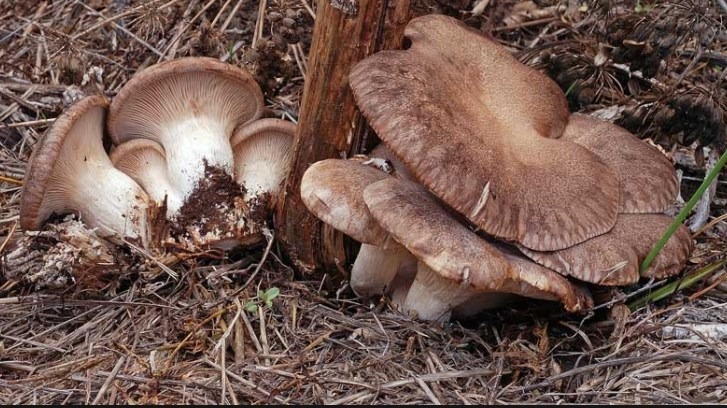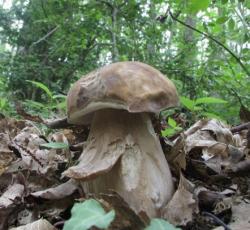Pleurotus eryngii is another mushroom with a delicious taste and greatly appreciated in gastronomy. This mushroom is very common in southern Italy and belong to the same family as the famous Pleurotus ostreatus.
Indice
Other names of the Pleurotus eryngii
Pleurotus eryngii is commonly called King trumpet mushroom . Other popular names are , French horn mushroom, king oyster mushroom, king brown mushroom. In Italy they call it “Cardoncello”. In Sardinia, especially in the area of Alghero and Sassari, is known by the name of Antunna.
Description of King trumpet mushroom
The pleurotus eryngii takes the form of a characteristic funnel, with gills decurrent on the stipe like other pleurotes and its wavy surface. The King trumpet mushroom is a species known since ancient times and is a species of a mushroom which is attempted cultivation in the greenhouse.
Cap
The cap of the mushroom pleurotus eryngii has a diameter ranging from 4 to 10 cm. Its shape is convex at the beginning of its growth and then becomes flat and slightly depressed in the central zone.
The shape is irregular and the margin smooth. The color is reddish brown sometimes is light or even dark or grayish. In fact, the color of the cap can vary from off-white to yellow ochre, passing through gray brown.
Gills
The gills are white or pink. They are uneven between them is very thin. A characteristic of pleurotes is that the gills are very arched and flow a lot on the stipe.
Stipe
The stipe of the pleurotus eryngii measures from 3 to 6 cm in height and has a thickness of 1 to 2 cm. Its shape is cylindrical and often becomes arched. The colour ranges from white to ochre and has a slightly striped surface.
Flesh
The flesh is firm and elastic in the stipe It has a light flour smell and a mushroomy, sweet taste.
Habitat and diffusion
The pleurotus eryngii is a kind of saprophyte fungus that grows in the ground and often in the shade of some bushes. It is widespread mainly in the Mediterranean. For example, in southern Italy and the islands is very common and is found on the roots of the dead wild thistles or in uncultivated places on the edge of roads, pastures and sandy soils.

Period of Growth
The King trumpet mushroom is found from spring until autumn and therefore covers almost the entire summer. It appears in late autumn and extends its growth until spring.
Varieties of King trumpet mushroom
Of the Mushroom pleurotus eryngii have been distinguished some varieties that differ from each other in relation to the habitat, the appearance that year and their color.
The variety Pleurotus ferulae has a larger size and is always whitish in colour. It grows on the roots of large umbrellas. The variety Pleurotus nebrodensis grows in Sicily and also grows on an umbrella.
Recipes with pleurotus eryngii
This mushroom is considered by many to be vegetable meat and is cooked in a grill as a steak using the whole cap or cooked in a pan. It is also used to prepare pasta sauces.
It can also be put in oil and in general pleurotus eryngii are suitable for any recipe, whether for fresh consumption or for storage and drying. Practically all the recipes of the pleurotus ostreatus can be used also for the pleurotus eryngii.
Grilled Pleurotus eryngii
Let’s get some carpophores of Pleurotus eryngii and set up a beautiful fire in the fireplace. Usually we use oak or olive wood to increase the aroma.
Heat the grill over the embers until it is almost hot and place the cleaned mushrooms on top of it. At this point, pour a little oil and salt over the mushroom and roast for a quarter of an hour depending on the thickness of the meat of the cap. Obviously, the mushroom should be placed with the gills facing upwards. Serve hot with the famous bread carasau (or guttiau) the classic Sardinian bread or even the soft flattened.
The cultivation of Pleurotus eryngii
All species and varieties of pleurotus eryngii mushrooms are suitable for cultivation. To do this there are various techniques developed by various growers.
For example, one technique is to engrave the “ferula” trunks (wild fennel) and inoculate them with the spores. Another technique is to bury bags of sterile substrate in a soil that has been inoculated with the mycelium of pleurotus eryngii. With this last technique the yield is very abundant.
The easiest way to grow them is through bales of mushrooms.
IDENTITY CARD
CAP COLOR: brownish
STIPE HEIGHT: 3-5 cm
STIPE COLOR:white
GILLS: whitish
FLESH: White
SMELL: Absent
TASTE:light
SPORES: white
HABITAT: Meadows with grass
Did you find what you were looking for? See also here:
- Ganoderma Lucidum
- Armillaria Mellea
- Amanita Caesarea
- Agaricus Bisporus
- Amanita Phalloides
- Coriolus Versicolor
- Flammulin Velutipes
- Marasmius Oreades
- Pleurotus Ostreatus
- Agaricus Campestris
- Macrolepiota procera
